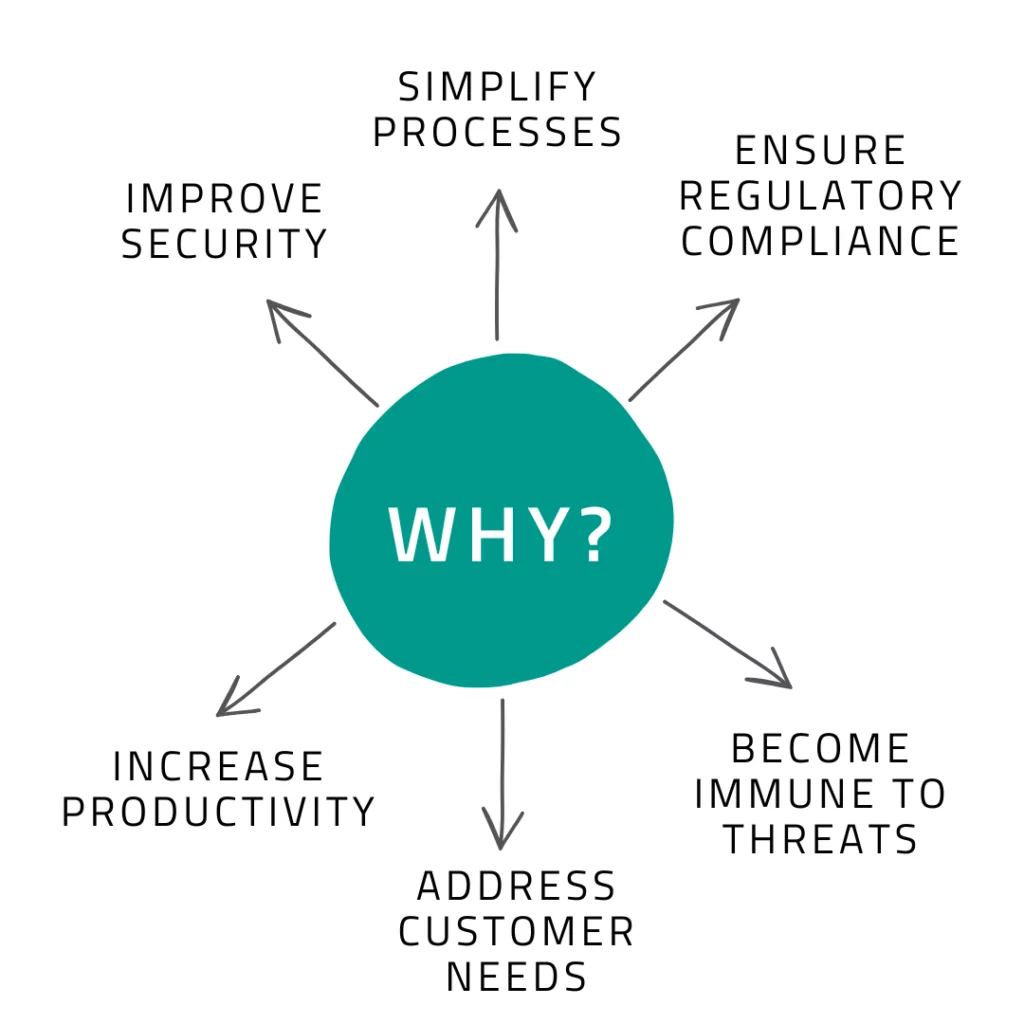Money makes the world go round, as the song goes. The financial sector provides services to commercial and business customers all over the world. This dynamic industry consists of entities including retail banks, commercial banks, neobanks, credit card companies, savings associations, and credit unions.
Ever since the Mesopotamians created the first known form of currency approximately 3,000 years before our era, the money’s circulating endlessly.
The ever-moving cash flow enforces keeping abreast with the times. The financial sector is always constantly alert to emerging novelties and employs modern solutions in its processes. Despite major crises in the past years, the industry is growing strong, and its digital field is expected to expand significantly in the coming years.
Is the future of banking digital?
The rising power of digital solutions couldn’t have gone unnoticed by the financial sector. Digital transformation, the process of adopting the newest technologies to boost efficiency, competitiveness, and innovation, is a path banks and other financial entities embark on. Under the umbrella term fintech (financial technology) the transformation takes place right before customers’ eyes.
Why do banks need digital transformation?
- To improve security
- To simplify processes
- To ensure regulatory compliance
- To increase productivity
- To address customer needs
- To become immune to contemporary threats

All roads lead to Rome (if by Rome we mean digital banking/financial services)
There’s no one right way for banking and financial institutions to transform digitally. Companies follow various digitization models, of which the two most common are digital as a new line of business (devoting a part of operations to be transformed, yet still maintaining traditional banking/financial services) and digital native – remaining up-to-date with the newest technologies since the very beginning of operations.
What slows down the progressing digitalization in the financial sector?
Despite the undeniable need for implementing newer and newer technologies, there are still obstacles to overcome. What hampers the digital transformation most are obsolete and inflexible IT infrastructures, too centralized to scale and handle the speed of incoming changes, so desired by modern banks and financial institutions.
Issues caused by obsolete IT infrastructure
Why do banks need digital transformations? The times are a-changin’ and what used to work well a decade or two ago, now turns out to be obsolete. Not paying enough attention to staying up-to-date with the changing world results in:
- Obstructed cooperation between dispersed teams and weak communication affect global processes and suppress innovation.
- Inability to gather and process data on clients in real-time. Older systems lock data in silos, shutting it from efficient analysis allowing a deeper understanding of clients’ needs.
- Low quality of digital experience delivered to clients, as refraining from modern solutions causes issues with multichannel and direct service available immediately.
- Challenges in implementing digital solutions obstruct the efficient generation of new products, sources of revenue, and new ways of engaging clients.
- Potential threats to customer data safety, and security breaches lowering users’ trust.
- Excessive costs resulting from e.g. maintaining out-of-date systems, eliminating consequences of the mentioned above issues, and the overall systems’ insufficiency.

7 examples of digital transformation in banking/financial services
In the third decade of the XXI century going digital is not about having a website or a banking app anymore. The list below presents some of the most remarkable, future-proof examples of digital banking.
Blockchain
The decentralized, distributed, immutable ledger of individual records (blocks) records transactions and allows tracking assets (both tangible and intangible).
In banking, blockchain plays various roles including:
Streamlined payments – with blockchain, banks can reduce the need for third-party verification, speeding up the processing of transactions. As a result, decentralization contributes to faster payments with lower fees. The same works for loans and credits, as processing loan applications involves assessment of debt-to-income ratio, credit scores, and ownership status, and blockchain backs the credibility of necessary data, speeding up the process.
Neobanking
Neobanks, known also as virtual, digital, online, or internet-only banks, operate exclusively online, without brick-and-mortar branches. This way of doing business appeals to tech enthusiasts’ taste, eliminating the need for handling any issues on-site. Neobanks offer mobile-focused services, using apps and dedicated platforms to satisfy customers’ needs. Some of the entities operating in this model sprouted from established traditional banks and function under their parent companies’ bank license, while many others emerge as standalone brands with built-from-scratch systems and platforms.
The advantage of neobanks is largely their flexibility, the speed of processes, and addressing market needs in a more agile way compared to traditional banks. As a result, online banks have a remarkable potential for narrow specialization focusing on specific demands, yet the market is still to verify whether there will be enough niches and take-up for numerous new players in the banking industry.
Artificial intelligence
The adoption of AI in banking is rapidly increasing. There’s no wonder, as machines are capable of performing human-like operations oftentimes not worse than the workforce does – and doing it 24/7 without holidays and sick leaves. One of the most common applications is chatbots, where AI answers inquiries on the current balance, upcoming payments, and other frequent queries. Employing algorithms to serve customers at the first line allows better allocation of expert personnel to handle more challenging tasks requiring the human touch.
Another instance of AI in banking is the role in credit scoring. Assessing borrowers’ creditworthiness by hand can (and usually is) be mundane and time-consuming. Algorithms perform the analysis of data from various sources, allowing for the creation of scoring models even in the case of individuals or companies with limited credit history.
Other fields in banking where artificial intelligence is used successfully are e.g. cybersecurity (improving financial systems based on data from previous breaches, learning from past mistakes, and analyzing patterns) and high-end advisory (suggesting steps beneficial to the customer based on their credit history, analysis of their finance, and the current offer of services).
Internet of Things
IoT combines the broad field of physical objects containing sensors and access to communication networks. The environment of interconnected devices is always on the lookout for useful information, gathering, and transferring data for future use. Moreover, IoT contributes to improving customer service and analytics, and can be used for real-time monitoring.
From interconnected devices mounted in financial facilities supporting on-site security with smart alarm systems, to mobile devices requiring biometric authentication and supporting fraud prevention, to leveraging data from everyday technology and wireless payments, the financial sector owes much to IoT.
Advanced data analysis
The key to offering tailor-made products and services with a superb user experience is understanding customers’ needs. Data-driven banking requires data on customer behavior, needs, and abilities. Remarkably, the financial sector is well-known for its early adoption of analytics, as the sector was always on the lookout for changes and disruptions, securing operations by examining historical data. In times of digital transformation, banking applies big data processes to squeeze even more valuable information from the available datasets.
Data is the greatest ally companies could imagine in delivering unique customer-centered solutions. Aside from building well-thought-out products, in-depth data analysis allows for more efficient resource allocation through process optimization, strengthening customer relations, mitigating risks, reducing operational costs, and creating successful strategies resulting in better performance.
Authentication
The process of verifying user identity and their clearance to access particular resources. Two-factor authentication (2FA), requiring an additional step aside from users’ names and passwords, adds another layer of security. The price for safety is convenience, as making the 2nd factor an obstacle for clients can result in abandoned carts, causing revenue loss and satisfaction decline.
A 2019 European Union regulatory requirement, the Strong Customer Authentication (SCA), should enable making online transactions even safer. SCA compliance entails possession (e.g. a hardware token issued to the client specifically), inherence (a physical attribute of the client, like biometric identification), and knowledge (something only the client knows, e.g. a PIN). The drive toward achieving maximum security of digital banking will continue, as fraudulent actions adopt the newest solutions as well – protection needs to be at least one step ahead of wrongdoers.
Payments
The financial sector comes up with newer and newer ways of improving and simplifying payment methods. The last 50 years have seen a journey from checks, through bank transfers to contactless payments, using smartphones, and other wearable devices, to the recently emerging payment chips to be implanted for the ultimate convenience of not carrying around any financial resources. Microchips, roughly the size of a grain of rice, are to be connected with a credit card and recommended to be placed into users’ hands for an undoubtedly hard-to-lose payment option.
The impact of digital transformation in financial services
The digitalization of the financial sector took off during the pandemic and there are no signs for tech adoption to stop. Other industries aren’t slowing down and banking needs to implement technologies to achieve its objectives. Examples of digital banking innovations mentioned in this article give a glimpse into the future of modern financial services – there’s still more to come in the years ahead.
Digital innovation in banking and financial services was never solely about creating responsive websites for brick and mortar branches. It’s a comprehensive approach to technology, paying enough attention to modern infrastructure, creating compelling products and services, and ensuring the right customer experience. All of which is possible by employing the right tools and approaches.
After all, even though there’s not that much of that clinking, clanking, clunking sound anymore, money still makes the world go ‘round. And state-of-the-art digital solutions are here to make the flow safe and efficient.
Curious about what custom software solutions can do for your enterprise? See our case studies to read about the success stories of our customers. Enjoyed the read and looking for more? Book your one-hour free consultation to talk about your idea and find out which digital transformation services will be the most beneficial.
Read more:
Digital transformation in manufacturing
Digital transformation in healthcare
Benefits of digital transformation
How to measure digital transformation





